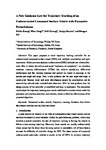A new guidance law for trajectory tracking of an underactuated unmanned surface vehicle with parameter perturbations
| dc.contributor.author | Huang, H | |
| dc.contributor.author | Gong, M | |
| dc.contributor.author | Zhuang, Y | |
| dc.contributor.author | sharma, sanjay | |
| dc.contributor.author | Xu, D | |
| dc.date.accessioned | 2019-02-19T12:26:26Z | |
| dc.date.issued | 2019-03-01 | |
| dc.identifier.issn | 0029-8018 | |
| dc.identifier.uri | http://hdl.handle.net/10026.1/13315 | |
| dc.description | Publisher’s embargo period: Embargo set on 01.03.2019 by SR (TIS). | |
| dc.description.abstract |
This paper proposes a novel trajectory tracking controller for an underactuated unmanned surface vessel (USV) with multiple uncertainties and input constraints. Unlike previous dynamic surface control (DSC) methods that utilize a first-order filter to obtain derivatives and avoid “explosion of complexity”, we introduce nonlinear tracking differentiators (NTDs) that achieve satisfactory differential performance and fast tracking response and control the vessel to converge to the pseudo-yaw angle and surge. First, a new guidance law for yaw angle and surge is constructed. Second, inner and outer disturbances caused by uncertainties can be observed by reduced-order extended state observers. With the new guidance law, the design process of the controller is simplified and easy to implement. The simulation results show the trajectory tracking error can be stabilized to a certain extent under the parameter perturbations and other uncertainties, which verified the effectiveness of the proposed algorithm. | |
| dc.format.extent | 217-222 | |
| dc.language | en | |
| dc.language.iso | en | |
| dc.publisher | Elsevier | |
| dc.subject | Unmanned surface vehicle | |
| dc.subject | Trajectory tracking | |
| dc.subject | Guidance law | |
| dc.subject | Active disturbance rejection control | |
| dc.subject | Input saturation | |
| dc.title | A new guidance law for trajectory tracking of an underactuated unmanned surface vehicle with parameter perturbations | |
| dc.type | journal-article | |
| dc.type | Journal Article | |
| plymouth.author-url | https://www.webofscience.com/api/gateway?GWVersion=2&SrcApp=PARTNER_APP&SrcAuth=LinksAMR&KeyUT=WOS:000461402500019&DestLinkType=FullRecord&DestApp=ALL_WOS&UsrCustomerID=11bb513d99f797142bcfeffcc58ea008 | |
| plymouth.volume | 175 | |
| plymouth.publication-status | Published | |
| plymouth.journal | Ocean Engineering | |
| dc.identifier.doi | 10.1016/j.oceaneng.2019.02.042 | |
| plymouth.organisational-group | /Plymouth | |
| plymouth.organisational-group | /Plymouth/Faculty of Science and Engineering | |
| plymouth.organisational-group | /Plymouth/Faculty of Science and Engineering/School of Engineering, Computing and Mathematics | |
| plymouth.organisational-group | /Plymouth/REF 2021 Researchers by UoA | |
| plymouth.organisational-group | /Plymouth/REF 2021 Researchers by UoA/UoA12 Engineering | |
| plymouth.organisational-group | /Plymouth/Research Groups | |
| plymouth.organisational-group | /Plymouth/Research Groups/Marine Institute | |
| plymouth.organisational-group | /Plymouth/Users by role | |
| plymouth.organisational-group | /Plymouth/Users by role/Academics | |
| dcterms.dateAccepted | 2019-02-10 | |
| dc.rights.embargodate | 2020-2-15 | |
| dc.rights.embargoperiod | Not known | |
| rioxxterms.versionofrecord | 10.1016/j.oceaneng.2019.02.042 | |
| rioxxterms.licenseref.uri | http://www.rioxx.net/licenses/all-rights-reserved | |
| rioxxterms.licenseref.startdate | 2019-03-01 | |
| rioxxterms.type | Journal Article/Review |


